Rotors and sails will reduce the ship’s fuel consumption by 10% and reduce CO2 emissions by 30%
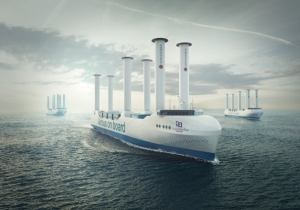
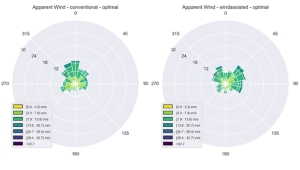
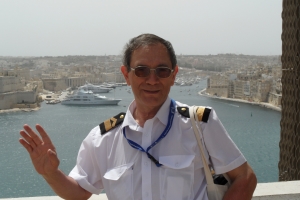 By Marek Grzybowski
By Marek Grzybowski
Ports must prepare to handle ships with sails and rotors. Oldendorff and Norsepower announced in February this year. concluding an agreement on the use of rotors to reduce CO2 emissions from a bulk carrier operated by a German shipowner. Norsepower Rotor Sails will allow you to use wind propulsion technology and reduce fuel consumption while traveling. With good winds, you can even count on reducing CO₂ emissions by up to 30%.
We could recently see what a ship using wind to support traditional propulsion looks like at the Port of Gdynia. Pyxis Ocean (229 m long, 32 m wide, 12.8 m draft) was serviced at the quay of the HES Gdynia Bulk Terminal. The sails and wings installed on the ship are designed to use the power of the wind to support the diesel engines. Thanks to the use of WindWings systems installed on the side, the 80,000-ton ship burns up to one fifth less fuel – claims the ship’s owner, Cargill. We wrote about the ship’s visit to the Port of Gdynia in GospodarkaMorska.pl.
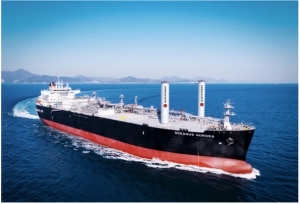
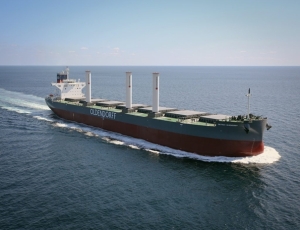
Rotor on a bulk carrier
Oldendorff and Norsepower decided to use a different solution. The Dietrich Oldendorff ship (235 m long, 38 m wide, draft – 9.3 m) is to be equipped with three Norsepower Rotor Sails with dimensions of 24 m x 4 m. From mid-2024, the unit should be used in commercial relations. The ship will carry bulk cargo on the trade route from the North Pacific to Asia.
“The Norsepower Sail rotor is a radically modernized, digital version of the Flettner rotor. It uses a minimal amount of the ship’s electrical energy to actively rotate cylindrical rotors on board the ship,” explains the design firm. Rotating with the wind thickens the air behind the sail and creates powerful thrust, saving fuel and reducing emissions.
This is not the only ecological accent of this solution. Norsepower emphasizes that the huge, spinning rotors are partly manufactured from approximately 342,000. plastic bottles.
The solution proposed to the company is already proven. This rotor design has been used by ship operators for approximately 10 years.
In real conditions, the rotors have worked for over 310,000 hours. hours on ships operated by several well-known shipping companies. The operators calculated that during this time they managed to reduce CO2 emissions by over 21,000. tone. Rotor assembly at Dietrich Oldendorff will take place in the second quarter of 2024.
Torsten Barenthin, Director of Research and Development at Oldendorff stated:
– We are extremely interested in reducing fuel consumption and emissions by harnessing the power of wind with Norsepower Rotor Sails, a proven, energy-efficient product.
– Oldendorff is Norsepower’s dream client in many respects: a family company with traditions, operating in the industry for over 100 years and currently owning approximately 700 ships – said Tuomas Riski, CEO of Norsepower, after signing the contract. – Oldendorff makes ecological shipping a reality today and is the best partner we can have on our path to zero-emission transport. I wholeheartedly welcome Oldendorff’s commitment to Norsepower’s mission to decarbonize shipping and look forward to future opportunities to collaborate! – emphasized Riski.


Less CO2 by 30%
Already working solutions allow you to determine the efficiency of the drive used. “We know that Norsepower Rotor Sails can reduce CO₂ emissions and increase fuel savings combined with cruise optimization,” emphasizes the design company. The research conducted allows us to answer the question of how much can be achieved using the construction of a modern sail or rotor.
Such tests were carried out on a tanker built by Sumitomo Heavy Industries Marine & Engineering. Norsepower says the research aims to introduce zero-carbon shipping. The study quantified the potential CO2 emissions and fuel savings resulting from installing a Flettner rotor on a tanker constructed at Sumitomo Heavy Industries Marine & Engineering.
A ship with rotors for Airbus
“Using digital twin technology and sophisticated sea state modeling, our team of experts demonstrated a 28% reduction in emissions during a transatlantic voyage between New York and Amsterdam, with voyage optimization contributing 12% and vortex sail technology providing the rest,” the construction company highlights. Norsepower calculated that “the average reduction in CO2 emissions across six different global routes was 19%, with journey optimization contributing to emissions reductions of 10%.”
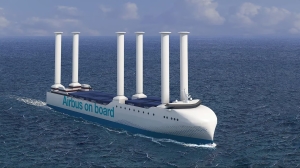
Also in February this year French shipowner Louis Dreyfus Armateurs SAS (LDA) and Finnish Norsepower Oy Ltd announced that Norsepower Rotor Sail technology will be installed on a new RoRo fleet ensuring lower exhaust emissions. The ships will be chartered by Airbus.
– Each of the new low-emission ships, which will be used to transport aircraft components for Airbus, will be powered by six 35-meter Rotor Sails installations from Norsepower and two dual-fuel engines powered by diesel and e-methanol – Norsepower informs.
In addition, software will be used to designate cruise routes. In this way, the operator will optimize the ships’ journey across the Atlantic, maximizing the use of wind propulsion and avoiding drag caused by unfavorable ocean conditions.
– While the IMO has set ambitious targets to bring shipping to net zero, wind propulsion is considered a viable element of a sustainable energy mix for maritime vessels. We are proud to be part of the energy transition through our collaboration with Norsepower to offer innovative solutions and drive change in a sustainable way, said Mathieu Muzeau, General Manager of Transport and Logistics at Louis Dreyfus Armateurs.
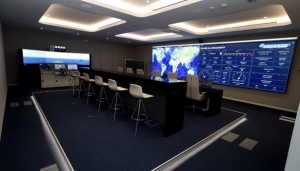
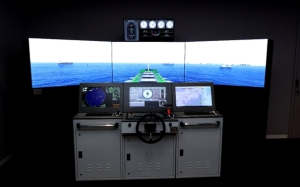
Sailing with the wind and under computer control
The shipowner announces that “by 2030, on the transatlantic route, the new fleet will generate approximately 50% less CO2 emissions compared to 2023. The rotor sails will be equipped with a completely new, patented NPSCTM system.”
The Norsepower solution enables real-time wind measurement, fuel economy monitoring and reporting of vessel operational activities. The IT system allows you to control each rotor.
This optimizes performance by managing the complex aerodynamic interactions between the rotors and the hydrodynamic behavior of the vessel. To optimize the arrangement and design of the rotors, extensive computational fluid dynamics (CFD) and wind tunnel testing was carried out during the design phase.
The mass introduction of ships with rotors and sails poses new challenges to ports. Even though the devices are foldable, they constitute an additional installation on board the ship that must be taken into account by the operator of the loading or unloading devices.
Today, a rotor or sail is a complex technical device with numerous controllers and actuators. You must be aware that these are not serial systems and any damage will require repair at a shipyard with specialized equipment and competences.
